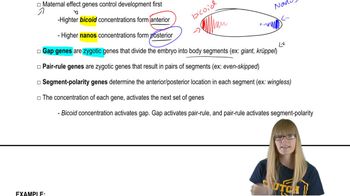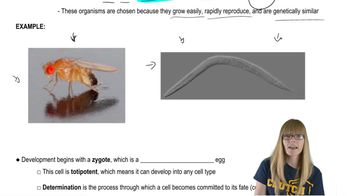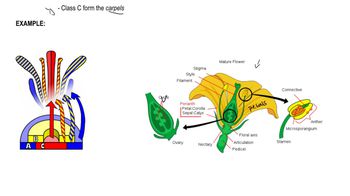Table of contents
- 1. Introduction to Genetics51m
- 2. Mendel's Laws of Inheritance3h 37m
- 3. Extensions to Mendelian Inheritance2h 41m
- 4. Genetic Mapping and Linkage2h 28m
- 5. Genetics of Bacteria and Viruses1h 21m
- 6. Chromosomal Variation1h 48m
- 7. DNA and Chromosome Structure56m
- 8. DNA Replication1h 10m
- 9. Mitosis and Meiosis1h 34m
- 10. Transcription1h 0m
- 11. Translation58m
- 12. Gene Regulation in Prokaryotes1h 19m
- 13. Gene Regulation in Eukaryotes44m
- 14. Genetic Control of Development44m
- 15. Genomes and Genomics1h 50m
- 16. Transposable Elements47m
- 17. Mutation, Repair, and Recombination1h 6m
- 18. Molecular Genetic Tools19m
- 19. Cancer Genetics29m
- 20. Quantitative Genetics1h 26m
- 21. Population Genetics50m
- 22. Evolutionary Genetics29m
14. Genetic Control of Development
Developmental Patterning Genes
Problem 12
Textbook Question
The homeotic mutation Antennapedia causes mutant Drosophila to have legs in place of antennae and is a dominant gain-of-function mutation. What are the properties of such mutations? How does the Antennapedia gene change antennae into legs?
 Verified step by step guidance
Verified step by step guidance1
<span>Understand the concept of homeotic mutations: Homeotic mutations are changes in genes that lead to the transformation of one body part into another. These mutations often affect genes that control the development of body segments.</span>
<span>Identify the nature of the Antennapedia mutation: Antennapedia is a dominant gain-of-function mutation, meaning that a single copy of the mutated gene is sufficient to cause the phenotype, and the mutation results in a new or enhanced function of the gene product.</span>
<span>Explore the role of the Antennapedia gene: The Antennapedia gene is part of the Hox gene family, which plays a crucial role in determining the identity of body segments along the anterior-posterior axis in Drosophila and other organisms.</span>
<span>Examine how the mutation affects gene expression: In the case of Antennapedia, the mutation causes the gene to be expressed in the head region where it is not normally active, leading to the development of legs instead of antennae.</span>
<span>Consider the molecular mechanism: The gain-of-function mutation in Antennapedia likely alters the regulatory elements of the gene, causing misexpression in the head region, which results in the transformation of antennae into legs.</span>
Recommended similar problem, with video answer:
 Verified Solution
Verified SolutionThis video solution was recommended by our tutors as helpful for the problem above
Video duration:
2mPlay a video:
Was this helpful?
Key Concepts
Here are the essential concepts you must grasp in order to answer the question correctly.
Homeotic Genes
Homeotic genes are crucial for determining the identity of body segments in organisms. They encode transcription factors that regulate the expression of other genes, guiding the development of specific structures. In Drosophila, mutations in these genes can lead to dramatic changes in morphology, such as the transformation of antennae into legs, as seen in the Antennapedia mutation.
Recommended video:
Guided course

Segmentation Genes
Gain-of-Function Mutations
Gain-of-function mutations result in a gene product with enhanced or new functions. In the case of Antennapedia, this mutation causes the gene to be expressed inappropriately, leading to the development of legs instead of antennae. Such mutations can provide insights into gene regulation and developmental pathways, often resulting in dominant phenotypes.
Recommended video:
Guided course

Functional Genomics
Gene Regulation and Development
Gene regulation is the process by which cells control the expression of genes, influencing development and cellular function. In Drosophila, the spatial and temporal expression of homeotic genes is tightly regulated to ensure proper segment identity. The Antennapedia mutation disrupts this regulation, causing misexpression that alters the developmental fate of antennae into legs.
Recommended video:
Guided course

Genetics of Development

 11:19m
11:19mWatch next
Master Segmentation Genes with a bite sized video explanation from Kylia Goodner
Start learningRelated Videos
Related Practice


